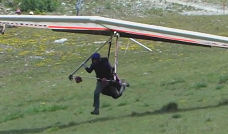
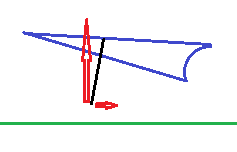
So how can I tell he's pulling the glider along? Look at the hang strap. The glider is starting to take his weight so the glider pulls up however the fact that the strap is sloping backwards proves he is pulling the wing forward. Move to the diagram. The force in a strap can only be tension. If it is the black line in my diagram then it is applying two forces at the bottom. One is a pull up and the other is a pull backwards. If it is pulling backwards, and I can assure you it isn't dragging John back up the hill, then John is pulling it along by the strap. His hands, meanwhile, are just getting on with the business of flying.
Now if you're going down hill, which I assume you are, tilt my diagram up. We don't actually care about vertical here just perpendicular to the direction of travel. You want to tow that glider so your arms come back to fly the wing and you lean forward to dig your toes in and run so you do indeed "dive through the frame." I've looked at web-forum pictures of people complaining about their launch and I draw a right-angle from the ground and compare it to the hang strap and now it all makes sense. If you are pushing on the frame you are telling the glider to nose up. That's how you land not take off.
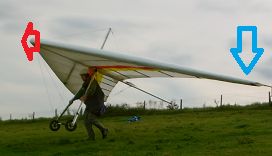 When you are standing at the launch point get the instructor to let go of the
nose as soon as possible. They are going to be going on about 'wings level' but
while they are holding the nose it isn't going happen. So what is the trick?
First keep the nose down so it isn't wibbling about but then physics takes
over. A glider that is pointing into the wind sits wings level. It's designed
that way, it simply can't help it. If a wing drops it is just because you are
not pointing it into the wind any more. Fix it. Turn away from the dipping
wing. This probably only involves swinging the nose left or right six
inches if you were there a moment ago and the glider flies back to wings level.
This is the 'no effort' way while trying to force something to go level when
the wind is saying go not level is daft. That wing can pick you off the ground
so you're better off not fighting it as it will win.
When you are standing at the launch point get the instructor to let go of the
nose as soon as possible. They are going to be going on about 'wings level' but
while they are holding the nose it isn't going happen. So what is the trick?
First keep the nose down so it isn't wibbling about but then physics takes
over. A glider that is pointing into the wind sits wings level. It's designed
that way, it simply can't help it. If a wing drops it is just because you are
not pointing it into the wind any more. Fix it. Turn away from the dipping
wing. This probably only involves swinging the nose left or right six
inches if you were there a moment ago and the glider flies back to wings level.
This is the 'no effort' way while trying to force something to go level when
the wind is saying go not level is daft. That wing can pick you off the ground
so you're better off not fighting it as it will win.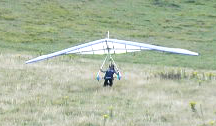 Weigh shifting is a good way to describe how we control things but I've fallen
into the trap of just twisting my body and seen countless other beginners do it
too. You are hanging from a big strap. Visualise it. If you want to bank left
pull that strap to the left. It looks more stylish if you keep your body
straight but us noobs really don't need to care about style yet. Give the strap
a push left then let it come back to centre, give the glider a second or so to
get its act back together and then decide if it needs another one. Only what
you do to the strap counts. If your chest goes one way and your feet go the
other and the strap stays vertical you have done absolutely nothing.
Weigh shifting is a good way to describe how we control things but I've fallen
into the trap of just twisting my body and seen countless other beginners do it
too. You are hanging from a big strap. Visualise it. If you want to bank left
pull that strap to the left. It looks more stylish if you keep your body
straight but us noobs really don't need to care about style yet. Give the strap
a push left then let it come back to centre, give the glider a second or so to
get its act back together and then decide if it needs another one. Only what
you do to the strap counts. If your chest goes one way and your feet go the
other and the strap stays vertical you have done absolutely nothing.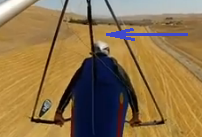 This was a real worry to me at first. I hadn't a clue how far it would fly and
just had to rely on the instructors but once I started flying more complex
plans it was my job to get it right. However it's quite simple: unless we find
rising or falling air we will descend at about 8 to 9 degrees. Hold your arm
out and make a fist with your thumb tucked in. If top of your fist is
horizontally out from your eyes in no wind you will land just under your fist.
Don't actually do it, you need to keep your hands on the bar but that's the
approximation, visualise it. For a ten mile per hour head wind you can roughly
double that. Two fists (please don't take both hands of the bar). It's not so
good as you run off from a hill as there is a lot of wind to come but it gets
better and better as you close in on the landing point and it's great for
decisions like 'zig-zag a bit, the canal at the far end of the field is
starting to look a bit close' or 'left a bit to avoid the down slope.' If you
know there isn't much wind budget for one fist, if there is a lot for more.
It's only a starter guess and you soon get the feel of it but I keep using it
as a check when I'm wondering where the next safe 'no lift' field is.
This was a real worry to me at first. I hadn't a clue how far it would fly and
just had to rely on the instructors but once I started flying more complex
plans it was my job to get it right. However it's quite simple: unless we find
rising or falling air we will descend at about 8 to 9 degrees. Hold your arm
out and make a fist with your thumb tucked in. If top of your fist is
horizontally out from your eyes in no wind you will land just under your fist.
Don't actually do it, you need to keep your hands on the bar but that's the
approximation, visualise it. For a ten mile per hour head wind you can roughly
double that. Two fists (please don't take both hands of the bar). It's not so
good as you run off from a hill as there is a lot of wind to come but it gets
better and better as you close in on the landing point and it's great for
decisions like 'zig-zag a bit, the canal at the far end of the field is
starting to look a bit close' or 'left a bit to avoid the down slope.' If you
know there isn't much wind budget for one fist, if there is a lot for more.
It's only a starter guess and you soon get the feel of it but I keep using it
as a check when I'm wondering where the next safe 'no lift' field is.